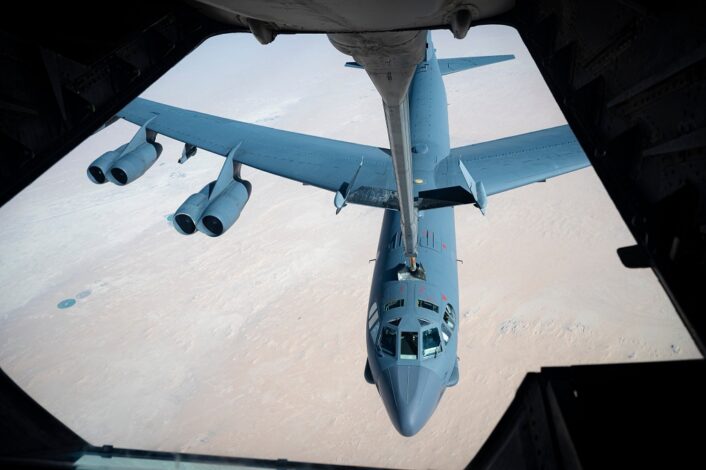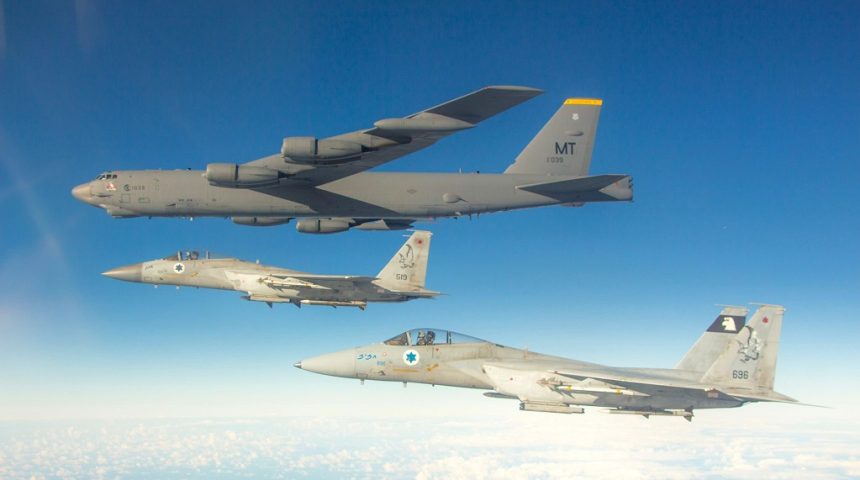The BUFF took off from RAF Fairford, where it is deployed as part of Bomber Task Force Europe, and integrated with Typhoons, F-15s and F/A-18s during a long-range presence patrol.
As we reported already, four B-52H strategic bombers of the U.S. Air Force deployed to RAF Fairford on February 10, 2022 for another rotation of the Bomber Task Force (BTF) Europe. The Stratofortresses, belonging to the 5th Bomb Wing from Minot Air Force Base, North Dakota, arrived as the military build-up in Europe and tensions with Russia are rapidly raising, but the USAFE-AFAFRICA command pointed out that the BTF 22-2 is a “long-planned” mission and not a consequence of the current situation around Ukraine.
A few days later, on Febr. 14, a B-52 performed a long-range mission to the CENTCOM area and back, logging about 23 hours and 30 minutes of flight.
Needless to say, the flight got a lot of attention online by aviation enthusiasts from all around the world on flight tracking websites. The flight departed as a two-ship shortly after midnight, with callsigns CHIEF11 (B-52H 61-0039) and CHIEF12 (B-52H 61-0018), and headed for the Atlantic Ocean, skirting the Spanish and Portuguese airspaces before crossing the Gibraltar Strait.
Yesterday evening USAF B-52H callsign CHIEF11 landed back at RAF Fairford in Gloucestershire after being in the air for approx 23 hours and 30 minutes. Incredible aircraft – incredible aircrews demonstrating their global reach #AvGeek #RadioGeek #MilMonWorld #Fairford https://t.co/s1YHNnOj14
— Military Monitoring World (@MilMonWorld) February 15, 2022
After crossing the Strait, about four hours into the flight, the two B-52 bombers started orbiting while waiting for the rendezvous with three KC-135 tankers, flying with callsigns LAGR965, LAGR966 and LAGR967. The five-aircraft formation performed the air-to-air refueling while flying alongside the border of the Barcelona FIR (Flight Information Region) towards the Balearic Islands. Upon reaching the island, the bombers turned south-east towards Italy.
Shortly after the refueling, however, CHIEF12 experienced unspecified problems as it was about to enter the Marseille FIR near Menorca and aborted the mission as a safety measure. The Stratofortress started flying the return leg towards the Gibraltar Strait, but later took a shortcut and flew over Spain on its way back to Fairford. The bomber, which was already flying lower than its usual cruise altitude, later transmitted a Pan Pan Pan emergency call, reportedly for engine problems.
B52 #CHIEF12 returning to Fairford declares PAN-PAN. Had flown at low altitude after refuel over the ‘Med.
PAN-PAN is the international standard urgency signal that someone aboard a boat, ship, aircraft, or other vehicle uses to declare that they have a situation that is urgent https://t.co/26Rmo5xnqP
— Col McGowan (OSINT) (@mm0ndx) February 14, 2022
A number of 🇺🇸U.S. Air Force Boeings B-52H Stratofortress are currently on a mission. One of them is #AE58A7, which should be 🇺🇸61-0018.
It looks like she may have had technical difficulties after refueling, causing her to cross 🇪🇦Spain at only around 16,000 ft. Returning home? https://t.co/95C2iPH0cw pic.twitter.com/QtuE7VnDcC
— Gerjon | חריון (@Gerjon_) February 14, 2022
CHIEF11 continued alone on its mission, flying towards Crete and Cyprus.
While in the area, the B-52 integrated with Typhoon FGR4 fighter jets of the Royal Air Force from the detachment at RAF Akrotiri. One of the Typhoons was trackable with the callsign RFR9711 (ZK346), most probably accompanied by a second Typhoon as flight history shows that it later flew towards Iraq with a Voyager KC2 tanker (RRR9831/ZZ338).
Both the tanker and the two Typhoons briefly joined the B-52, as CHIEF11 was heard on radio confirming to Nicosia control that it was currently flying in a four-ship formation and RFR9711 confirmed they were in formation with the bomber. Interestingly, the Stratofortress flew within 100 km from the Russian bases of Tartus and Latakia in Syria, before turning south towards Egypt.
🇺🇲#USAF
61-0039 / #CHIEF11 / B-52H
0745z – working Nicosia Control 129.550; #CHIEF11 confirmed they are 4 ship formation @ FL280
🇬🇧#RAF Typhoons #RFR9711 flt also working Nicosia Radar (presumably x2 EUFI) confirmed they currently in formation with #CHIEF11 flt…
— SR Airband & Aviation 📡✈🌍 (@Andy007_SR_A) February 14, 2022
By the way, two other Typhoons were trackable in the same area near Cyprus, one of them being RRR09692 (ZK342) while the other was not transmitting its callsign (ZK682). However, they did not join the formation as they were returning to RAF Coningsby with stops in Souda Bay and Grosseto Air Base.
In recent years, we have never tracked a B-52 so close to Russian bases in Syria.#NATO #Russia #Ukraine https://t.co/JYbcMlMmOt
— Itamilradar (@ItaMilRadar) February 14, 2022

CHIEF11 continued the flight over the Red Sea before turning east over Saudi Arabia over Jeddah. While it was there, as confirmed in a U.S. Air Force press statement on DVIDS, the bomber was refueled by a KC-10 tanker and joined by two U.S. Marine Corps F/A-18 Hornets for the first presence patrol of 2022 in the CENTCOM area of responsibility.
Regional & coalition air forces joined a @AFGlobalStrike B-52H Stratofortress from @US_EUCOM and 2 @USMC F/A-18 Hornets on a presence patrol mission across @CENTCOM today, demonstrating the @usairforce‘s ability to seamlessly operate across combatant commands. pic.twitter.com/LMLlxvxDyo
— US AFCENT (@USAFCENT) February 14, 2022
“Today’s B-52-led demonstration of joint, coalition, and partner nation combat airpower was a powerful projection of our combined strength across the Middle East,” said Lt. Gen. Greg Guillot, 9th Air Force (AFCENT) commander. “By originating outside the CENTCOM AOR, the mission also exemplified the U.S. Air Force’s ability to deliver combat airpower seamlessly across multiple combatant commands.”
#المقاتلات_السعودية ترافق قاذفة أمريكية إستراتيجية من نوع (بي-52).https://t.co/mZthOWKXcq pic.twitter.com/7FwAKjR6rE
— وزارة الدفاع 🇸🇦 (@modgovksa) February 17, 2022
While the press statement only mentioned unspecified regional partners, the Ministry of Defense in the Kingdom of Saudi Arabia published the photos of four F-15SA escorting the B-52H. Interestingly, the Eagles are flying with a very heavy air-to-air loadout which includes two external fuel tanks, four AIM-9L/M Sidewinder IR-guided missiles and eight AIM-120 AMRAAM radar-guided missiles.
Following the successful completion of the patrol, the B-52 begun tracing back its route. While flying near Israel, the BUFF (Big Ugly Fat Fellow) was joined by two IDF F-15s and a camera ship. The two fighters were possibly on Quick Reaction Alert duties, as photos show them armed with live Python 4/5, AIM-7 Sparrow and AIM-120 AMRAAM air-to-air missiles like during a similar flight last year (which, by the way, saw exactly the same bomber flying over Israel).
מטוסי ״בז״ (F-15) ישראליים ליוו היום (ב׳) מפציץ אמריקאי מדגם B-52, אשר חצה את שמי מדינת ישראל בדרכו מהמפרץ.
הטיסה התקיימה כחלק משיתוף הפעולה ההדוק עם צבא ארה”ב, שמהווה נדבך משמעותי בשמירה על ביטחון שמי מדינת ישראל והמזרח התיכון. pic.twitter.com/c7ChOyvUge
— Israeli Air Force (@IAFsite) February 14, 2022
The flight continued uneventfully until the bomber landed back at RAF Fairford after almost 24 hours of flight. While the U.S. Air Force officially stated that this mission’s objective was the Middle East, many viewed it as a deterrence mission or show of force for the current Ukrainian crisis and expected the B-52 to fly over the Black Sea, joining the RC-135s, RQ-4s and the other Intelligence, Surveillance and Reconnaissance assets that are crowding that area every day.
United States Air Force B-52H Stratofortress 🇺🇸61-0039/#AE58B2/#CHIEF11 over 🇪🇬Sharm El-Sheikh, Sinai Desert, Egypt, 14 Feb 2022 08:32 UTC, 🛰️Sentinel-2.
MLAT tracks ended >100 km further North, so it was a bit of a search.
📍28.03597,34.42347
🗺️ https://t.co/pceGc9Z75A https://t.co/D87Vw7GAEZ pic.twitter.com/APPC3IKGkf
— Gerjon | חריון (@Gerjon_) February 14, 2022
Another interesting aspect of the mission was related to the aircraft itself, as the B-52H 61-0039 is one of the 46 nuclear-capable Stratofortresses, as can be noticed from the fins installed as external identifiers under the START (Strategic Arms Reduction Treaty) treaty. The so-called shark fins can be found in their original position only on the combat coded jets, allowing to check by satellite how many bombers are combat ready, as required by the treaty. Because of this, many rumored about the presence of nuclear weapons on the aircraft as it flew mainly over the sea, however this is highly unlikely.









